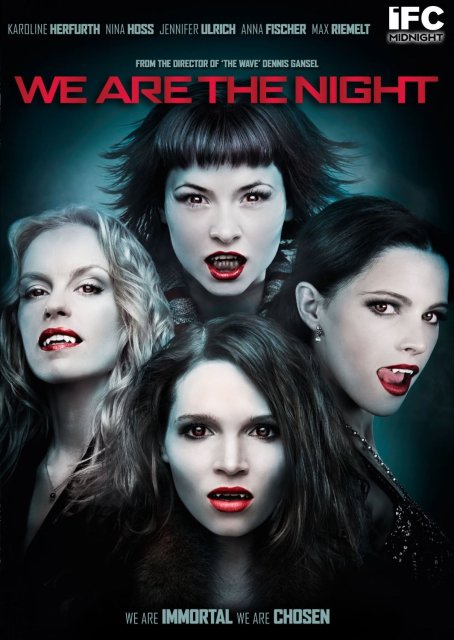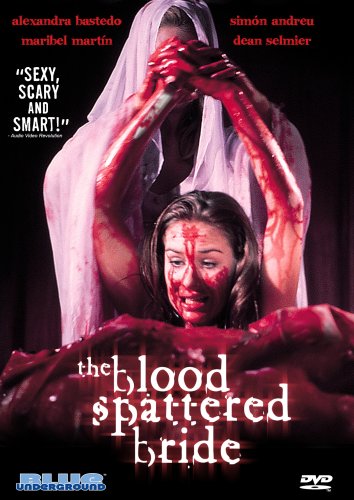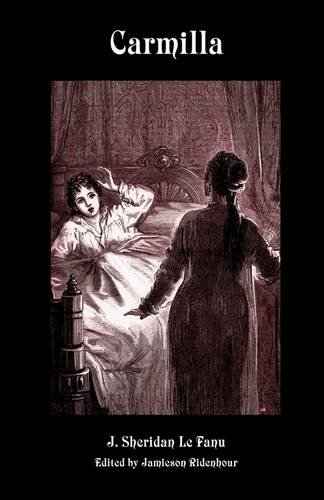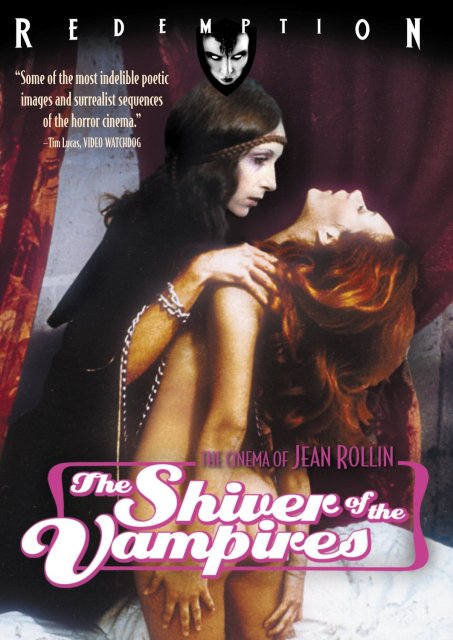I’m like everybody else: I have problems, I have concerns, and, mostly, I have complicated feelings on lesbian vampire movies. Here’s the thing: lesbian vampires have a place in both literature and film as being pretty much exclusively the creations of men. From Geraldine in Coolridge’s Christabel to Jess Franco’s Vampyros Lesbos and beyond, vampires and lesbians have been pretty much married in the minds of the insecure male storytellers of our lives. As heterosexual vampire stories had their origin in the fear of female sexuality, displayed clearly in novels like Dracula which consistently robbed its female characters of sexual autonomy throughout the narrative, lesbian vampire stories are clearly based in the insecurity that a supernatural being, aka gay person, could potentially come seduce girlfriends, or wives, or co-workers, or moms away. And that’s legit, because I think we can all agree that vampires are sexier than human boyfriends with control issues, who can’t even fly, or turn into a bat or anything. I mean, the exact plot of ‘vampire seduces woman with a boyfriend, boyfriend comes to murder vampire’ has been going on for centuries. So, Western World vampire tropes are pretty explicitly grounded in the patriarchy, and, as we all know, nobody wants to see that.

On the other hand, horror films are deeply important to queer culture, as they were pretty much the only films at all where we saw blatantly gay characters throughout most of the 20th century. Horror was often already low budget and shown in limited theaters, and the genre had little to lose and much to gain in the pushing of the envelope. The use of taboo to convey greater political meaning is central to the very concept of horror, and what’s more taboo in 20th century America than two adult women without boyfriends? Lesbians in specific were more workable for audiences if they were highly sexualized, sought to kill and replace men as any self-respecting straw feminist would, and, most importantly, were ultimately killed for their treachery. The violence against the vampire character is always unsettling for its real life implications, mostly that we are societally trained by much of our media to believe that violent actions are acceptable recourse in primarily emotional matters. Pro tip: violence is never the answer, particularly if your girlfriend starts dating someone new, even if she’s a vampire. Predictably, the sex in all of these films is the very definition of male gaze, which… might not surprise you, but I mean… still sucks, come on. Vampire or no, the empowerment/disempowerment process that occurs to all of the female characters is formulaic at best, and it demonizes queer women and spreads a violent message about us at worst.
The thing I really need to talk about, though, is that I kind of love the vampires in vampire lesbian movies. As an empowered gay woman, let’s just say that finding counterparts that I identify with in cinema isn’t the easiest thing in the world. When I do find images of independent women in art of any kind, I can tend to get pretty attached to them, to Hell with the consequences. Lez face it, the vamps in these stories have great lines, their sexuality is often revolutionary, and overall, horror films are more likely to pass the Bechdel Test than pretty much any other genre of film, and that goes double for ones about vampire lesbians. For a great many years, there were more queer vampire movies than there were queer any-other-genre-of-movie, by quite a wide margin. I didn’t make the world, I’m just living in it. It’s hard to be a queer film buff and not have serious feelings about this stuff.
It’s easy to describe the storylines for lesbian vampires, because they’re almost always the same exact thing. Whereas we have at this point seen every conceivable kind of straight vampire, we have seen really only one type of queer vampire, and these movies tend to follow very strict formulas. We have the seemingly straight woman, always white, usually blonde, and either engaged or married to a useless male character, often with a mustache, always a really uncool mustache. Enter our friendly neighborhood Vampyros Lesbos, who is dressed fabulously and has great hair. Her super sexiness intrigues the significantly-less-straight-as-time-goes-on blonde woman. The vamp comes in through a window and says something a total babe would say, then they make out. The girlfriend gets really stoked, but then all weak and wigged out because, well, she’s becoming a vampire, aka gay person. And that’s hard. Then, right when I was about to call it a day and wish the happy couple a wonderful living death together, the boyfriend shows up, says some sexist nonsense, and murders the vampire. It’s a happy ending? For everyone but me? Because, let’s face it, I get so sad at the end when the vampire dies that I’m started to sort of think I’m kind of missing the point of these films.

Depending on what your level of tolerance for depictions of sexual violence in film is, there are many moments in the queer vampire canon that I really can’t condone. This is the case with most vampire films, which often display a lack of consent on the part of the victim. I find this aspect of the relationships in these films to be mostly manufactured and inorganic; a way of explaining the girlfriend’s sexual interest in the vampire without damning her to the same moralistic fate. In the instances that the girlfriend character admits freely her attraction to the vampire, she seems to doom herself simply by speaking the words. The difference between who lives and who dies is often explicitly based around how gay they are. The vampire always dies, and the seduced woman lives only if she is strong enough to fend off the advances of the vampire.
This trope of “the lesbian must die” occurs in films from Blood & Roses in 1960 to We Are the Night in 2011, and dozens in between. As in 1972’s The Blood-Spattered Bride, we see the victim exhibiting the specific symptoms of dreaminess, weakness, and sexual hyper-awareness. The interjection of supernatural power into these narratives comes off as the epitome of male storytellers displaying subconscious fear of female sexuality while paradoxically dismissing the woman as weak, under the influence of someone else, and ultimately in need of saving. The general message here is that male sexuality is powerful, female sexuality is “just really confused, okay?!” This is not to pardon the fact that there are definitely depictions of acts of sexual assault in some of these films, and that those scenes are unfailingly difficult to watch. My only point is I don’t think these screenplays were always written by people that particularly understood female sexuality, and there are certain tropes that exist within the scripts that aren’t doing queer women any favors, one of them being the obviously offensive implication that all lesbian sex is predetermined to be criminal.
The “cure” for queerness is easy: the boyfriend kills the lesbian character, and suddenly, his girlfriend is straight again. If she stays queer, she is doomed to become a vampire herself. There is no third option. For instance, in The Blood-Spattered Bride, we observe the main character Susan as she grows from flighty young bride to misandrist lesbian who despises the men in her life. She’s married to one of the creepiest creeps of all time, but it is ultimately her queerness that leads her down the path of ruin. In one of the strangest sequences in film history, woman named Carmilla (surprise!) is carried right to Susan’s doorstep, completely naked, by her husband. Susan thinks, “Whoa, this naked lady is so girlfriend right now,” and she just goes for it. She spurns the advances of her overly aggressive, patriarichal husband in favor of making out with Carmilla, and then helps her murder pretty much all the male characters. Well, violence is never the answer, but I have to admit that those guys are all huge jerks, and maybe if they had just let Susan be gay from the start, none of that would have happened. Also interesting, and surprsingly rare, is that Blood-Spattered Bride explicitly refers to the main character as a lesbian. In fact, she chooses the term, and the whole movie is more or less her really horrible, really tragic coming out story. So, clearly, the complaint that these films are often misogynistic is perfectly valid, and yet, this and some other lesbian vampire movies either criticize the patriarchy or outright condemn it. The Blood-Spattered Bride does so with its upsetting sexual violence and its deeply intriguing main character, who at one point literally locks herself in a cage to escape her husband’s advances.

The first examples of lesbian vampires were, in poetry, 1797’s Christabel by Samuel Coleridge; in literature, 1871’s Carmilla by Joseph Sheridan Le Fanu; and in film, 1936’s Dracula’s Daughter, a sequel to the highly successful Dracula starring Bela Lugosi. Dracula’s Daughter was the first strongly implied lesbian vampire according to most film historians. The first explicitly queer vampire film was 24 years later, the much more graphic Blood & Roses, about a bisexual woman lusting after both her cousin and his fiancée. Blood & Roses inspired many dreamy art house horror films in the years to follow, including Vampyros Lesbos and the Hunger. Christabel is commonly considered an unfinished poem, and we never quite figure out what happens after she and the vampy Geraldine get it on. Carmilla features everything that would now be considered a trope of lesbian vampires, up to the hyper-sexualized vamp and the naive, formerly straight girlfriend character. Dracula’s Daughter introduced the first neurotic vampire to the realm of cinema, as well as being an early example of the predatory lesbian cliché that dominated the public perception of queer women throughout most of 1940s & 1950s.

While most of these stories follow a specific formula, there are definite deviations from the standard format. One example is 1983’s The Hunger, which has its flaws, but is one of the more popular candidates for feminist discussion. First deviation from the standard trope in the Hunger: the vampire is married! WoHAOAHhaoahaA! Who even knew that was POSSIBLE? And she and her husband hang out in goth clubs and pick up swingers to make out with and then kill, because that’s just the kind of thing that happened in the 80s, at goth clubs, in movies. Second, Susan Sarandon’s character, Dr. Sarah Roberts, is definitely empowered. She’s not only a doctor, but she’s, like, a really good doctor, with a strict moral code, that… honestly doesn’t really do her any favors in this story. Third, this movie doesn’t just pass the Bechdel Test, it passes it with flying colors, as the film is more about the female characters than the male by quite a long shot. The exception is the bizarrely sympathetic David Bowie, who appears throughout the first half of the film as John Blaylock, the undead-but-rapidly-becoming-dead-dead husband of Catherine Deneuve’s captivating turn as the bisexual vamp, Miriam Blaylock. He goes to see Dr. Roberts for help she can’t possibly give as he rapidly perishes, while Miriam somewhat heartlessly uses the brief interaction between her dying husband and some babe doctor as a way to pick up a new girlfriend. She invites Dr. Roberts into her home, and the rest is history. Consistent with many lesbian vampire films, it is her autonomy that dooms her.

My primary example of lesbian vampire films that break the mold, however, would be the films of Jean Rollin, including Fascination and The Shiver of the Vampires. One thing to keep in mind when you walk into a Jean Rollin movie is that most of his films were only funded based on him selling them to studios as pornographic, so there are definitely some extended sex scenes in here. I think some of them are pretty rad, some of them are a little too long, and at least one of them completely freaks me out. As always, I leave it to you to decide what your breaking point is as an audience member. Personally, Fascination is just one of my favorite horror films ever made. It follows a lone theif, who steals a bunch of gold from… a small group of theives (I know, right). The group comes after him, and he holes up in a castle in the middle of nowhere. We are introduced to bisexual couple Elizabeth and Eva, who apparently just hang out in said castle making out all day long, which sounds pretty much like the perfect life, to be honest. What’s the moral of this story, again? At this point in the narrative, there is so much explicit sex that it kind of takes the plot a while to catch back up again. When it does, we watch as Eva absolutely terrorizes the group of theives. After she disposes of them all, a coven of vampire witches shows up, and honestly the story just gets gradually weirder and weirder until the utterly bizarre finale. All of the art house elements of this film are really on-point, and it’s visually very dreamy and beautiful. Also, wow, speaking of relating too much to the vampires, I am pretty in love with the character Eva through this whole film, and I honestly forgive her for wreaking terror upon the countryside, mostly because the countryside totally deserved it. Also, because she does it naked. With a scythe. Eva is portrayed by Rolin regular Brigitte Lahaie, who comes across as really smart and cool in interviews. Check out this one from 2006 where she discusses her films with Rollin:
Also to their credit, many of the wide selection of lesbian vampire films are backed by supremely talented actors. Stand-outs include Soledad Miranda from Vampyros Lesbos, who was unknowingly playing one of her final roles. She died shortly after the filming of what became her most famous film, making her portrayal of Countess Nadine especially haunting. Before starring in some of the more sexualized Jess Franco films, she had a somewhat unexpected history as a young pop star in Spain, and you can watch one of her videos here.
Then there’s Catherine Denueve of the Hunger, who is one of the great actors of the last century, and whose career has spanned 50+ years and over 120 films. She has worked with some of the best directors of all time, and has an singularly remarkable resume, to the point where the Hunger, although probably her most famous part in an American movie, is really the least of her cinematic triumphs. Besides being pretty much the best actor, she has a background of activism and charity work that is really interesting to read about, as do her co-stars. In Daughters of Darkness, the lead role of the vampire is played by Delphine Seyrig, who worked with many great art house directors in the 1970s, quite memorably as the lead role in Chantel Ackerman’s infamous Jeanne Dielman, 23 quai du Commerce, 1080 Bruxelles. These women are all supreme talents, and I don’t think it’s a mistake that they chose to play these autonomous, intimidating vampires, particularly amid the desolate landscape of strong female roles in the late 1970s. Not only do the films attract a certain type of audience, but they also often attract a specific kind of actor.
Finally, lesbian vampire movies have easily some of the best soundtracks of all time. Vampyros Lesbos was famously sampled for Quentin Tarentino’s Jackie Brown, The Hunger features the goth-industrial band Bauhaus in the opening sequence, and later delves into a selection from Léo Delibes’ opera Lakmé, and the creepy/dreamy style of Hammond organs of the 1970s are all over these selections, to my utter delight. If there is a take-away from these movies that I don’t find problematic in the slightest, it would definitely be their almost-always supreme musical scores, which, as someone that relates way too heavily to lesbian vampires, I consider to be more or less the music of my people.
Is that enough reasons why these films are sometimes terrible, sometimes controversial, and yet, sometimes actually really great? If you need to find me to talk about it, I’ll be headed over to that village with my scythe.



More than enough reasons. Have you seen “Kiss My Blood”? It is a kind of a kitchen-sink vampire movie which goes from domestic drama to full-on adventure, with a kind of wry humour and attempts at ironic distance. Also: very hot.
I remember seeing this one years ago (it came out in the late 1990’s if I am remembering correctly). Might have to go looking for it again.
This is super interesting! Thanks for sharing!
David Bowie, 80’s goths and vampire lesbians sounds like Friday nights at my best friend’s house!
next time, we are watching the Hunger. For sure.
What about A Girl Walks Home Alone at Night? That’s a newer take on the female vampire at least, and though not gay, the character is arguably feminist. https://www.youtube.com/watch?v=_YGmTdo3vuY
Great article! I know this is mainly focused on movies, but I think this article warrants a mention of the Carmilla web series. You mentioned the book that the series is based on, but the web series that has been produced has taken many tropes you speak of and turned them around on themselves! The lesbian vampire is there, but the seduced woman is also queer, and so are many, many members of the cast. If you haven’t seen it already, definitely dedicate the next 3 hours of your life to Season 1, and then 4 more hours to Season 2! https://www.youtube.com/watch?v=h4QzRfvkJZ4&list=PLbvYWjKFvS5rX2yv-k5AJ8oxPoZ9zHcpe
the new carmilla is not exactly scary, but it does feature feminist themes,lesbians and vampires, so it’s pretty good
Yes, but what about ‘Nadja’? I mean the 1994 David Lynch film starring Elina Löwensohn (which is already reason enough for me to watch it). It is not unproblematic, of course, but here the bisexual female vampire actually kind of WINS in the end. And merges with another woman.
It is not lesbian (more like bisexual) but I thought it was worth mentioning.
Nadja had a very limited release and distribution if I remember correctly and if you’ve managed to see it you’re lucky.
It’s more an actual art house film than hm say your standard exploitative “lesbian vampire” film.
Definitely worth a mention, not disputing that in the slightest, and has that Roads song in it. It seems like some not intended for the straight male gaze.
Great article! I have a total soft-spot for lesbian vampire movies (largely because they are usually total trash). Agreed on Fascination being great, but it is disappointing that these films are always so obviously about hetero/male objectification-fantasies of lesbians and male insecurity. So that’s why my Halloween costume was modern-day Vampire Lesbian Separatist, complete with denim jacket, PBR, and misandrist knuckle tattoos.
I don’t think Vampyros Lesbos is really supposed to be anti-lesbian. The boyfriend doesn’t kill the vampire and no, it’s not played out as a happy ending. Bittersweet rather. In fact, in the alternate Spanish version, Linda tells Nadine that she wants to free her from her misery. At the end, her thoughts are very ambivalent but she says she’ll never forget the vampire meaning she still has feelings for her. The whole film itself is really intended to be an inverted version of Count Dracula so the vampirism shouldn’t really be interpreted as a metaphor for homosexuality.
Blood-Spattered Bride…I dash off to take a shower every time I think of that movie. According to the director, it was meant as an indictment, rather than a celebration, of Franco-era Spanish male machismo — but it fails so utterly to communicate that, that it becomes exactly the opposite: a grubby, hateful little film in which an abusive, rapist scumbag becomes the hero saving the world from deviant ladies. It’s like the 1970s Eurosleaze movie equivalent of one of those Men’s Rights dudes sitting in front of a camera and posting videos to youtube. I sort of have the same problem with the much better Under the Skin, in which a rapist “saves the world” from another strange woman. She’s not exactly a vampire, but then, she also kind of is.
Anyway, fantastic article!